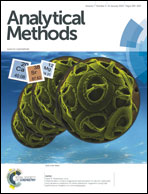Electrochemical behavior of a pheochromocytoma cell suspension and the effect of acrylamide on the voltammetric response†
Abstract
The electrochemical behavior of electroactive species in a pheochromocytoma cell (PC-12) suspension was studied to establish a simple and rapid measurement method to obtain strong and direct electrochemical responses that objectively reflect cell viability. Two electrochemical signals of the PC-12 suspension, caused by the oxidation of guanine, xanthine, adenine and hypoxanthine, were simultaneously detected by using a glass carbon electrode modified with a multi-walled carbon nanotube–graphene nanosheet hybrid film. The presence of the four purines in the PC-12 cell cytoplasm was verified by HPLC assay using a DAD system and LC-MS analysis. Additionally, a linear relationship between the peak currents of purines in the cell suspension and culture time was found, which is in accord with the cell counts. The cytotoxic effect of acrylamide (0.1 mM to 10 mM) on cells was evaluated by differential pulse voltammetry (DPV) analysis, which detected a decrease in the voltammetric response of purines in the cytoplasm, in agreement with that obtained by the MTT test and with morphological analysis. Therefore, the voltammetric response of the ultrasonicated PC-12 cell suspension could be used to monitor cell growth and to evaluate the effects of potential toxic hazards on cells, and in drug screening.


 Please wait while we load your content...
Please wait while we load your content...